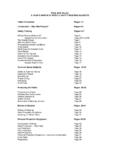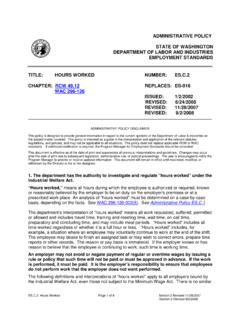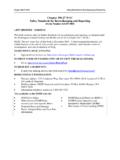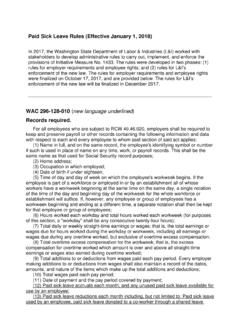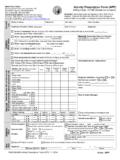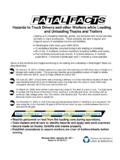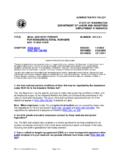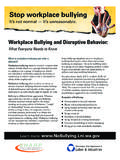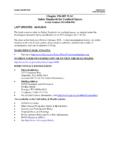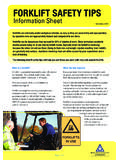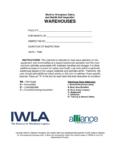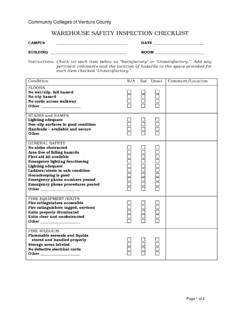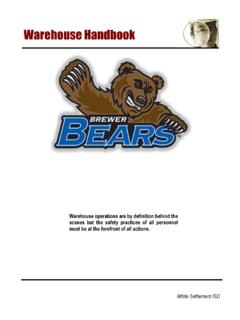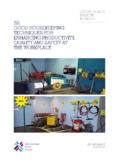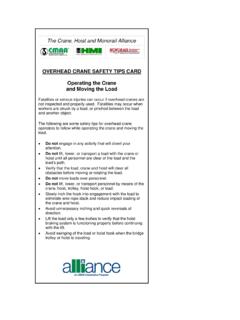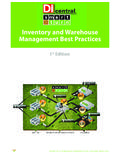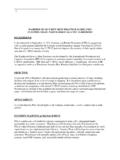Transcription of F417-031-000 Forklift Safety Guide
1 Forklift Safety Guide Learning the safe way to operate a Forklift and other powered industrial trucks may save your life Division of Occupational Safety and Health 1-800-423-7233. A. Contents Forklift Safety Guide How This Book Can Help Prevent Forklift Accidents .. 1. Introduction .. 2. Types of Forklifts .. 3. Forklift Operators Must be Trained .. 6. How a Forklift Works .. 8. Safely Using a Forklift .. 15. Driving Indoors and In Other Enclosed Locations .. 23. Maintenance of Forklifts .. 26. Summary .. 27. Appendix Operator's Daily Checklist .. 28. Resources .. 29. Get 1-on-1 Assistance .. 30. DISCLAIMER: This document discusses forklifts. Forklifts are a type of Powered Industrial Truck (PIT) and must meet the applicable standard requirements found in Chapter 296-863 WAC. Forklifts are not the ONLY. type of PIT. Each piece of equipment must be evaluated to determine whether or not it meets the definition and is covered by the standard.
2 How This Book Can Help Prevent Forklift Accidents This book has general information about: L&I's Standards That Regulate Forklifts The kinds of forklifts and powered Safety rules developed under the Washington industrial trucks commonly available. Industrial Safety and Health Act (WISHA). The principles that allow a Forklift to lift regulate the safe use of powered industrial and move heavy loads safely. trucks in Washington workplaces. You can find these rules in: Forklift operator training requirements. Basic operator Safety rules. WAC 296-863: Forklifts and other Powered Industrial Trucks Hazardous locations where carbon monoxide is a problem or a special Forklift WAC 296-155: Construction Standard is needed. WAC 296-307-520: Agriculture Standard Safety while servicing a Forklift . WAC 296-56-60077: Longshore, Stevedore and Related Waterfront Standard This book is not designed to substitute for operator training in the operation of specific You can get a copy of these rules on our forklifts and other powered industrial trucks website at or by used in your workplace.
3 Calling the L&I office nearest you. Whenever you see this symbol in the book, it means that failure to follow the instructions can result in serious injury or death. 1. Introduction A Forklift is a powerful tool that allows one person to precisely lift, move and place large heavy loads with little effort. Using a tool such as a Forklift , cart or hand truck instead of lifting and carrying items by hand can reduce the risk of suffering a back injury. However, there is great risk of injury or death when a Forklift operator: Has not been trained in the principles of physics that allows a Forklift to lift heavy loads. Is not familiar with how a particular A Forklift operator was pinned and killed when the Forklift the worker was operating overturned. Forklift operates. Operates the Forklift carelessly, unsafely or without knowing the hazards Uses a Forklift that is not safe due to malfunctioning, missing parts or unapproved alterations.
4 Approximately 35,000 serious injuries and 62,000 non-serious injuries involving forklifts occur in the United States every year. OSHA. estimates 11% of all forklifts are involved in accidents every year. Fatal accident type Percentage Crushed by vehicle tipping over 42%. Crushed between vehicle and a surface 25%. Crushed between two vehicles 11%. Struck or run over by a Forklift 10%. Struck by falling material 8%. Fall from platform on the forks 4%. 2. Types of Forklifts A Forklift is a type of powered industrial Electric Motor Narrow Aisle Trucks truck (PIT) covered by Safety standards. A (solid tires). PIT is a mobile, power-driven vehicle used to carry, push, pull, lift, stack or tier material. Forklifts come in many sizes and capacities. They can be powered by batteries, propane, gasoline or diesel fuel. Some are designed to be used in a hazardous location or atmosphere where an ordinary Forklift might cause a fire or explosion.
5 There are several different types of PITs that are used in different types of industries. Stand-Up Rider Narrow Aisle Some of the types are shown below. The Forklift has straddle legs on both sides of the forks to provide stability in the absence of a counterweight in the body. Electric Motor Counter-Balanced Trucks Electric Motor Hand Trucks or Hand/Rider Trucks (solid and pneumatic tires) (solid tires). Sit-Down Rider Motorized Hand Pallet Jack The Forklift has a counter balance weight in the body. A low-lift (ground level) unit has forks or a platform. Some models allow the operator to stand on the back. Others are walked. A high-lift version has a mast and straddle legs. 3. Types of Forklifts Internal Combustion Engine Trucks Internal Combustion Engine Trucks (solid tires) (pneumatic tires). Sit-Down Rider Sit-Down Rider The Forklift has a counter balance in the rear.
6 The Forklift has a counter balance in the rear. Electric and Internal Combustion Engine Tractors Rough Terrain Forklift Trucks (solid and pneumatic tires) (pneumatic tires). Sit-Down Rider Rough-Terrain Reach Forklift The Forklift has a draw bar that is capable of pulling The Forklift has large pneumatic tires, and a boom which heavy loads. raises and extends. Outriggers at the front stabilize the Forklift on soft or uneven ground. A rough-terrain Forklift might also resemble a sit-down rider as shown above. However, it is bigger with large pneumatic tires and a large mast with large forks. It is powered by an internal combustion engine. 4. Sometimes special attachments are installed onto the forks to extend the reach, clamp a barrel, act as hoist, lift odd-shaped items like a roll of carpet or even lift people. Using an unapproved attachment could alter the Forklift 's lifting and balance characteristics and cause the Forklift to overturn.
7 Whenever an attachment is used that could affect the capacity or safe operation of a Jib Crane Attachment Forklift , its use must be approved by the Forklift manufacturer. The employer must mark the Forklift to show the new weight with attachment. The maximum capacity at the highest elevation must also be shown. Drum Grabber Attachment Personnel Platform Hoist Attachment Carpet Lifting Attachment 5. Forklift Operators Must be Trained An untrained Forklift operator can be as dangerous as an unlicensed driver of a motor vehicle. State regulations require the employer to ensure that a Forklift operator is competent to operate the Forklift he or she is assigned to employer must document operator training and an evaluation of the operator's performance while using the Forklift . The topics listed below must be covered when Forklift operators must be trained in the operating training a Forklift operator.
8 However, if a instructions, warnings and precautions for the types of forklifts they will be authorized to use. specific topic does not apply to the Forklift in the employer's workplace, covering it is optional. Any inspection and maintenance that the Topics related to forklifts operator will be required to perform Operating instructions Refueling Warnings and precautions for the types Charging and recharging of batteries of Forklift the operator will be authorized Operating limitations to operate Any other operating instructions, warnings Differences between a Forklift and or precautions listed in the operator's automobile manual for the types of Forklift that the Controls and instrumentation: employee is being trained to operate Where they are located, what they do and how they work Topics related to your workplace Engine or motor operation Surface conditions where the Forklift will be operated Steering and maneuvering Visibility (including restrictions due Composition of loads to be carried and load stability to loading).
9 Fork and attachment adaptation, Load manipulation, stacking and un-stacking operation and use limitations Forklift capacity Pedestrian traffic in areas where the Forklift will be operated Forklift stability 6. Qualified Trainers: The employer or any other person the employer chooses who has the knowledge, training and experience to train and evaluate Forklift operators can do this training and evaluation. The trainee can operate the Forklift only when directly supervised by such a person and when this would not endanger anyone. Documenting Training: If the operator had previous Forklift training, the employer must document that the training covered the required topics described above. The operator must have been evaluated in the current Narrow aisles and other restricted places workplace within the last three years. where the Forklift will be operated Training and Evaluation Records: The employer Use of door opening and closing devices must keep a record that shows that each Hazardous (classified) locations where the Forklift operator has been trained.
10 The record Forklift will be operated must include the name of the operator, date of Ramps and other sloped surfaces that training, date of evaluation and the name of the could affect the Forklift 's stability person(s) giving the training and evaluation. Closed environments and other areas Refresher training must be given if the where insufficient ventilation or poor operator has been involved in an accident, a maintenance could cause a buildup of near miss or unsafe operations. Also, if an carbon monoxide or diesel exhaust operator is assigned to a new type of Forklift Other unique or potentially hazardous or if workplace conditions change and an environmental conditions in the evaluation shows they are not operating it workplace that could affect safe operation safely, then refresher training is required. 7. How a Forklift Works Driving a Forklift is Different Than Driving a Car In a car or truck, the front wheels steer the vehicle.
